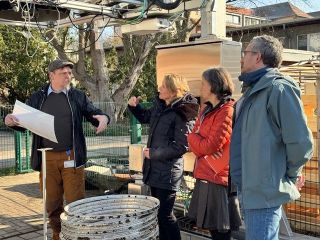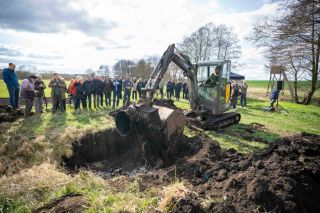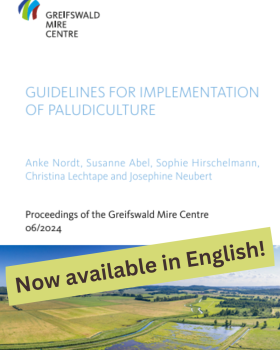News
2025
Mire for Minister
by Helena Plochberger (comments: 0)
Current research presented

01/04/2025 We were able to present the current status of research and databases to Environment Minister Steffi Lemke (BMUV) during her visit at the Greifswald Mire Center.
Mire research plays an important role in the research strategy of the University of Greifswald, explained Vice-Rector Peter Michalik in his opening speech. The minister was interested in the measurements of plant biomass and greenhouse gases in the mesocosm facility, the reed collection and the oldest book in the bog library explained by Franziska Tanneberger, Gerald Jurasinski, Sebastian van der Linden and Hans Joosten, but she was also particularly impressed by our peat mosses, which Greta Gaudig showed her.
Paludiculture, biodiversity and peat formation were among the other topics part of the exchange - as well as the outlook for future research, as it will take place in the Collaborative Research Center of the German Research Foundation (DFG) WETSCAPES 2.0. Therefore, the GMC representatives were very pleased that the Minister was accompanied by Nathalie Niederdrenk and Ulf Hauke from the Department of Soil and Mire Protection.
Ground-breaking ceremony & Sernitz
by Helena Plochberger (comments: 0)
Rewetting has started

01/04/2025 A symbolic ground-breaking ceremony marks the start of the establishment of a wet meadow paludiculture by the toMOORow initiative - wet mires for a sustainable future. The peat meadows in the Sernitz Mire serve as a model project: drainage ditches are now being filled in, sills are being built in the flow to retain water and a sustainable use through paludiculture covering an area of around 80 hectares will then be established with local farmers. The measures help to keep water in the landscape, reduce greenhouse gas emissions by up to 1,200 tons of CO₂ equivalents per year and enable the reintroduction of typical peatland plant and animal species.
The initiative is thus continuing years of work to restore natural conditions in the Sernitz Moor in the “Schorfheide-Chorin” biosphere reserve as part of the LIFE project “Lesser Spotted Eagle”. In consultation with local residents and land users, measures for water retention were developed, pastures for water buffalo were established and a mire experience trail was designed, to name just a few examples of the successful project.
The Federal Ministers Steffi Lemke and Cem Özdemir attended the launch, as they see the activities in the Sernitz as a strong signal for sustainable peatland use by the toMOORow initiative of the Succow Foundation, partner in the Greifswald Mire Center, and the Michael Otto Environmental Foundation.
Kicking off WETSCAPES 2.0
by Helena Plochberger (comments: 0)
with people on a 2-day event

01/04/2025 WETSCAPES 2.0, a large, interdisciplinary science consortium dedicated to researching rewetted fens started today with a 2-day meeting at Rostock University of more than 50 scientists from diverse fields, including 22 Principal Investigators (PIs) leading various subprojects, along with many Early Career Researchers (ECR).
Their diversity highlighted just how complex and ambitious this research programme funded by Deutsche Forschungsgemeinschaft is, aiming to investigate approximately 100 screening sites, 5 core sites, and two landscape-level experiments in rewetted peatlands of Mecklenburg-Vorpommern. This federal state has rewetted already more than 10% of its peatland area and is frontrunning in developing solutions for wet peatland use (paludiculture, carbon credits, nature tourism, peatland photovoltaics). Now, the CRC will add a massive effort in fundamental research in rewetted fens.
The kick-off included a trip to one of the planned screening sites, where installed the first of our 1,000 sensors used for the project’s data collection! For some of us, it was the first visit of a North-German fen. They are almost everywhere and look often like 'normal' grassland!
Besides the funding of the Deutsche Forschungsgemeinschaft (DFG) - German Research Foundation, the Transregio Collaborative Research Centre (CRC) 410 is additionally supported by Universität Greifswald Universität Rostock, Leibniz Institut für Gewässerökologie und Binnenfischerei (IGB), Humboldt-Universität zu Berlin, GFZ Helmholtz-Zentrum für Geoforschung and the Max Planck Institute for Biogeochemistry Ludwig-Maximilians-Universität München.
Newly translated into English!
by Helena Plochberger (comments: 0)
Guide to Implementing Paludiculture

20/03/2025 Our Guide to Implementing Paludiculture is now available in English - good news for people in sustainable agriculture and climate initiatives, in eco-aware businesses and other!
If you're looking to manage peatlands sustainably but unsure of where to begin, this comprehensive guide is your go-to resource. From assessing site suitability to navigating permits and optimizing biomass utilization, we've compiled practical insights to support your efforts.
This newly translated and formatted version is part of our GMC publication series, making it even more accessible for all stakeholders involved in sustainable land management. It is based on the original publication Leitfaden für die Umsetzung von Paludikultur, released in 2022.
MoorPower
by Helena Plochberger (comments: 0)
Solar on peatland feasible?

17/03/2025 Competition for land in Germany is fierce, but is it possible to combine uses such as photovoltaics and the rewetting of peatland? The newly launched MoorPower project is taking a close look at the general feasibility of solar pan elson peatland with simultaneous rewetting. It is also investigating whether this concept makes rewetting more attractive for farmers.
Since the beginning of 2023, the German government has been promoting the construction of solar systems on peatland that was previously drained for agriculture if it is permanently rewetted. The concept is new. So far, there is only one PV system on rewetted peatland known in Germany and none abroad. TThus, there is considerable need for testing and research in order to be able to assess possibilities and effects.
“It is important to develop only drained and heavily degraded peatlands, i.e. peatlands currently used for agriculture, for the dual use of carbon storage in peat and the production of renewable energy via photovoltaics. It must be prevented that peatlands are used for the installation of photovoltaic systems without being rewetted, because then the greenhouse gas emissions from the peatlands would continue,” said Prof. Dr. Jürgen Kreyling from the University of Greifswald. “Peatlands and peat soils of nature conservation value within legally protected areas are excluded.”
And this is what the research looks like in practice: On an experimental site in Mecklenburg-Western Pomerania, the scientists are building system designs on a total of six hectares of fen that is still used for agriculture, with different mounting heights, solar module types and foundations. They then combine each PV system variant with three different water levels and examine their ecological impact. The project team is testing different materials, coatings and methods for the foundations of the special PV systems on a material test area in Baden-Württemberg. As shade from the solar modules can have an impact on the growth of typical peatland plants, they are also investigating this in pot experiments. The scientists at the Thünen-Institute are analyzing the impact of peatland PV on the greenhouse gas balance on a practical scale on around 200 hectares of rewetted peatland with photovoltaics in Lower Saxony.
Research for MoorPower is jointly conducted by the Universities of Greifswald and Hohenheim Johann Heinrich von Thünen-Institute and the Fraunhofer Institute for Solar Energy Systems ISE.











